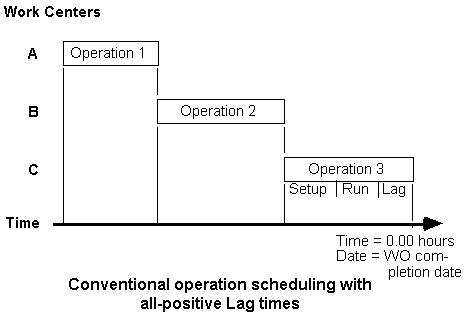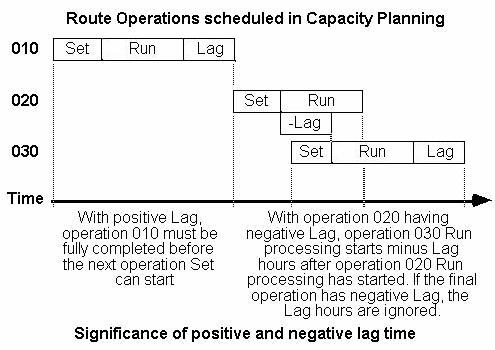– Capacity Planning Menu
Capacity Planning gives time information obtained from existing WO and Jobs and optionally MRP forecast requirements. The analysis is based on process route operation times and Work Centre parameters.
![]() NOTE: Capacity Planning is not available to those who only have licensed the Inventory version of the program.
NOTE: Capacity Planning is not available to those who only have licensed the Inventory version of the program.
|
Line |
Function |
Keys |
|---|---|---|
|
Run Capacity Analysis |
To run or re-run capacity analysis. You will be offered options for the run. See the Capacity Planning Run Selection topic. If you operate any other Capacity Planning menu function, this function will automatically operate before operating the function you have selected. |
|
|
Show Calendar |
Provides a listing of the current Make Calendar set up under manager controls. See the Make Days Calendar topic. |
Ctrl+D |
|
Show Work Centres |
Provides a list of all Work Centres with details. See the Work Centre List topic. |
Ctrl+W |
|
Show Work Operation List |
Provides a chronological list of Work Operations showing the times and dates on which they should be processed. See the Work Operations List topic. |
Ctrl+O |
|
Show WO Kit-to List |
Provides full Work Order Kit-to listing to be used by the stores to schedule kitting. See the Work Order Kit-To List topic. |
Ctrl+K |
|
Show WC Loading |
Provides a graphical representation of loading on a selected Work Centre or Department. Select a Work Centre from any list first. See the Work Centre Loading Chart topic. |
Ctrl+L |
|
Show WC Make-to List |
To obtain a chronological list of work to be done at the particular Work Centre or Department. Select a Work Centre from any list first. See the Work Centre Make-To List topic. |
Ctrl+T |
|
Ignore Lag in Loading Chart |
Loading analysis chart will include operation lag time. Operate this command to switch to show the chart excluding any lag time. |
|
|
Analysis by Department |
Make-to and loading analysis will be by Work Centre. Operate this command to switch to Departmental analysis. |
|
|
Scheduler Transfers |
Transfer functions to external third-party Finite Scheduler programs. See the Capacity Scheduler Data Transfer – Preactor topic. |
|
|
Print Work Centre List |
Provides a printed report of all Work Centre details. |
|
|
Print Work Operation List |
Provides a chronological list of Work Operations showing the times and dates on which they should be processed. |
|
|
Print WO Kit-To List |
Provides a printed report of the Work Order Kit-to listing. You will be presented with a date range selection Capacity Report Options dialog. |
|
|
Print WC Loading |
Provides a printed report of Work Centre or Departmental loading. If no WC is selected you will get reports for all. You will be presented with a date range and option selection Capacity Report Options dialog. |
|
|
Print WC Make-To List |
Provides a report of the WC or Department Make-to Listing. If no WC is selected you will get a report for all. You will be presented with a date range and option selection Capacity Report Options dialog. |
|
Introduction to Capacity Planning
Capacity Planning is the term used to describe analysis of actual or forecast Work Order and Job operations and the impact they have on Work Centre resources. The process can be run for created and incomplete Work Orders and Jobs, or to also include MRP forecast Work Order recommendations.
Capacity Planning does not create any data records in the data file. The process of analysis is carried out in terminal memory only. The only effect on data you can have is the change of Work Order completion dates.
Capacity Planning takes Operation data from Process Routes and Work Centre records and bases all scheduling calculations from the start of the day of each Work Order planned completion. For Jobs it takes each the individual Operation and uses it’s completion date. There is no scheduling of Operations within Jobs as that is controlled within Job maintenance.

With conventional positive Lag time, the start of the Operation is calculated back using the Set hours + Run hours times WO quantity + Lag hours as the duration in hours that the operation consumes Work Centre resources. This duration is then divided by the Work Centre hours per day to fix the start date and time in working hours for the Operation. The start time for this operation is then taken to be the end time for the preceding Operation, and so on until all operations are scheduled. This process is carried out for each Work Order included in the analysis. The dates are all taken from the Make calendar.
If the Lag time is negative, the run time of the preceding operation will be scheduled to start the absolute number of Lag hours before the start of the run time of this operation. In this way operations can be carried out partly in parallel.
![]() TIP: If you set an operation’s Lag time at -0.01, the following operation will, in effect, run in parallel to it. However, if the run duration of the first operation is greater than the run duration of the following one, sequencing will fix the two run completion times to be the same.
TIP: If you set an operation’s Lag time at -0.01, the following operation will, in effect, run in parallel to it. However, if the run duration of the first operation is greater than the run duration of the following one, sequencing will fix the two run completion times to be the same.
If you leave a negative Lag Time on the last operation of a route, scheduling will be calculated using zero.

![]() NOTE: In capacity planning operations of outwork work centres are scheduled on the positive Lag Time only. Such operations use setup and runtime for costing purposes only. Lag time enables you to correctly schedule for outwork processing duration between normal in-house work centre operations within the route.
NOTE: In capacity planning operations of outwork work centres are scheduled on the positive Lag Time only. Such operations use setup and runtime for costing purposes only. Lag time enables you to correctly schedule for outwork processing duration between normal in-house work centre operations within the route.
![]() WARNING: If part Lead Times are shorter than those calculated from Operation times, kitting of the Work Order may be recommended differently from MRP.
WARNING: If part Lead Times are shorter than those calculated from Operation times, kitting of the Work Order may be recommended differently from MRP.
Each Work Order or Job Operation is scheduled backwards, relating processing duration at Work Centres to their capacity, yielding values of real dates and times. This conversion of hours to time assumes that the Work Order is passing through the Work Centres in isolation from all other Work Orders that may also need to be processed in the same Work Centres at the same time.
This approach is known as Infinite Capacity Planning. This means that in scheduling it assumes unlimited Work Centre availability to handle multiple Work Orders and Job Operations and makes no attempt to automatically smooth resource loading. If the analysis were to reschedule Operations so that a fixed limit of Work Centre activity was never exceeded, the system would have to make assumptions about prioritising that could be dangerous with respect to the supply of materials or deliveries to customers.
The Infinite model enables you to view the loading on Work Centres that will result from your current production objectives. You are then in a position to make decisions about load smoothing by changing Work Order completion dates or changing the capacity of Work Centres.
Compiled in Program Version 5.10. Help data last modified 4 Jun 2012 04:47:00.00. Class mCapacity last modified 18 Apr 2012 12:39:39.


